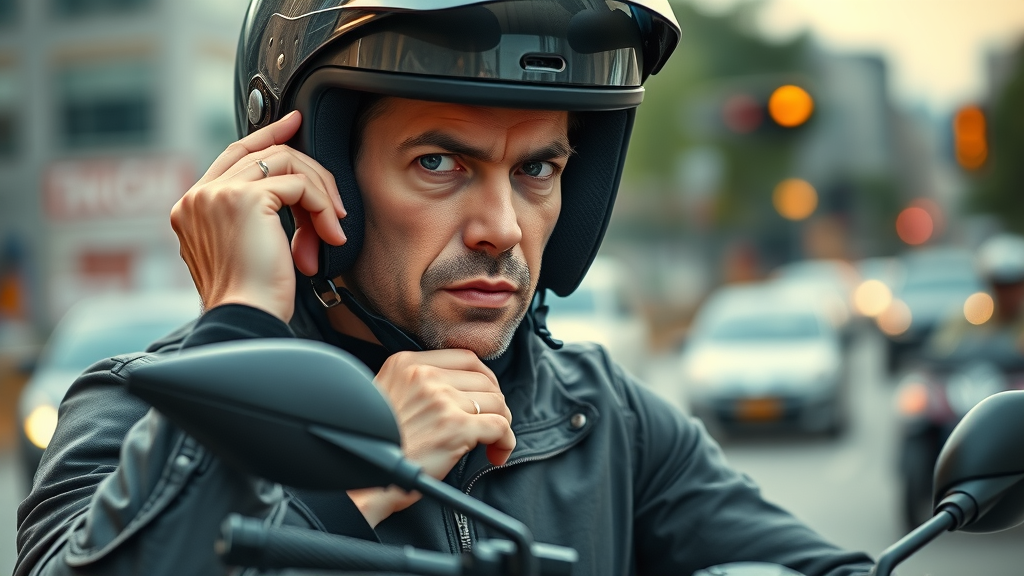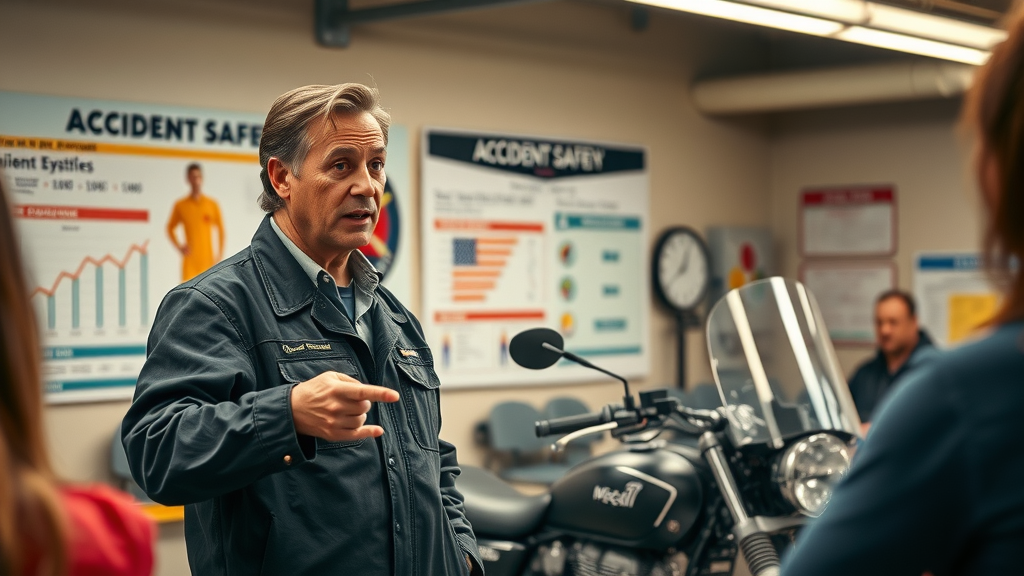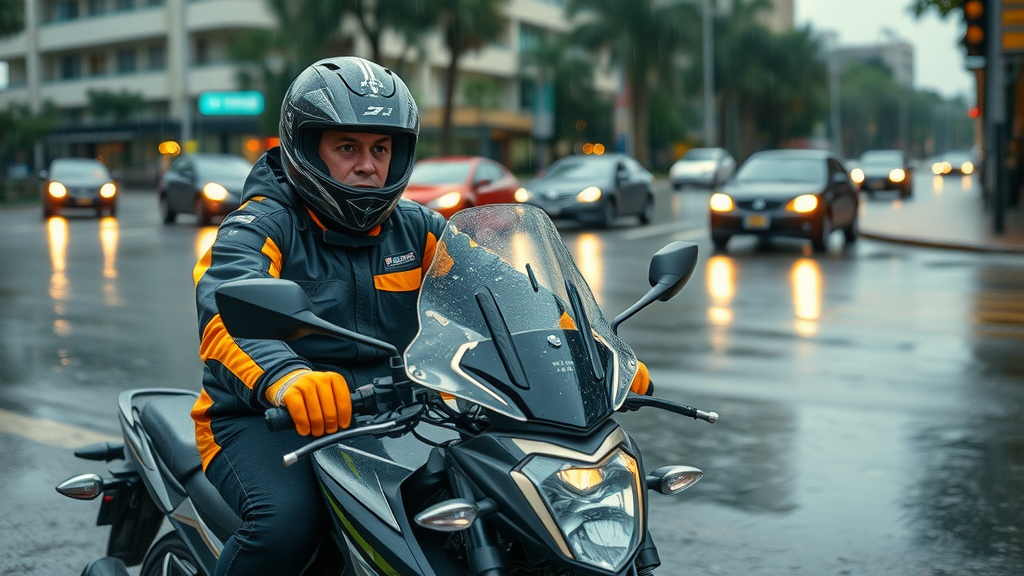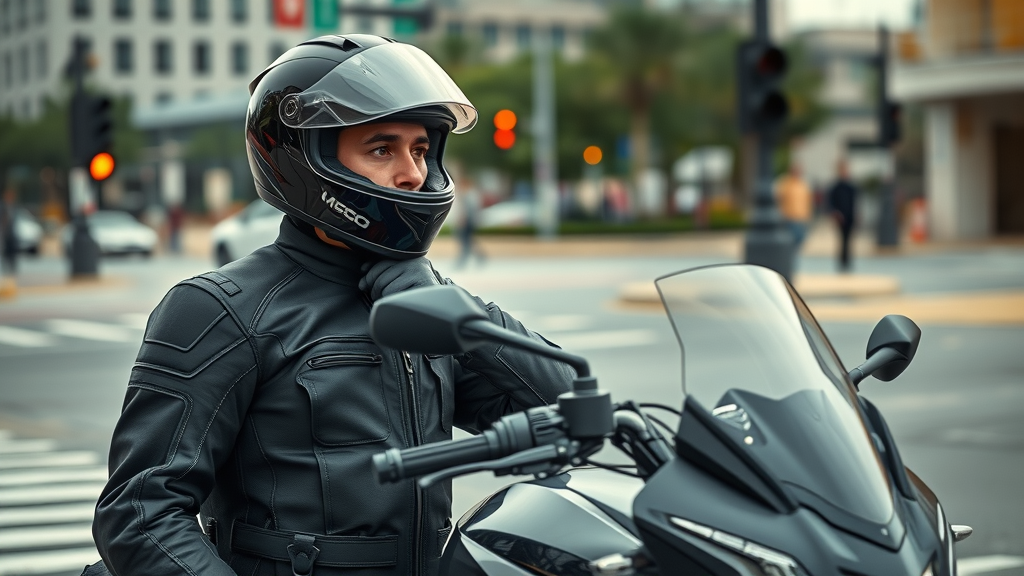Did you know that while motorcycles account for less than 3% of registered vehicles in the United States, motorcyclists represent 14% of all traffic fatalities? This stark reality highlights the critical need for every motorcycle rider to prioritize safety—long before hitting the ignition. Whether you’ve just started riding a motorcycle or have years of experience, practicing effective motorcycle safety tips can mean the difference between an enjoyable ride and becoming another troubling statistic. Ready to take charge of your safety? Let’s dive in.

Mastering Motorcycle Safety Tips for Every Motorcycle Rider
Being a motorcycle rider is exhilarating, but your safety should always come first. Mastering motorcycle safety tips involves more than just wearing protective gear; it means understanding the road, your abilities, and other road users. Whether you're cruising city streets or tackling winding country roads, these insights will help you stay prepared for any situation.
Start by routinely reviewing the basics: always perform pre-ride checks, plan your route, and dress for visibility. Defensive driving is essential—ride as if you’re invisible to others because many drivers simply do not see motorcyclists. Stay aware of your surroundings and be ready to react to changing traffic conditions. Incorporating these motorcycle safety tips into your routine will not only help you stay safe but also enhance the enjoyment and confidence you feel while motorcycle riding.
For a deeper understanding of the risks motorcyclists face and how accident trends are evolving, you may find it helpful to review recent motorcycle crash statistics in the USA . This data-driven perspective can further inform your approach to safety and highlight areas where extra caution is warranted.
Understanding the Reality of Motorcycle Safety and Motorcycle Accidents
The risks faced by motorcycle riders are vastly different from those encountered by people driving a car. Without the protective shell that cars provide, riders are far more vulnerable to road hazards and inattentive road users. According to the National Motorcycle Safety Foundation, the number of motorcyclists killed in traffic fatalities continues to rise, often due to preventable causes. Public awareness campaigns and rider education are crucial to reversing these statistics, yet the onus remains on each individual to commit to motorcycle safety.
Motorcycle accidents frequently occur when least expected—whether while changing lanes, negotiating road tracks, or reacting to sudden obstacles. Studies show that a significant percentage of motorcycle accidents happen at intersections and involve other vehicles failing to yield. Experienced riders know that developing a keen sense of awareness, honed through instruction and experience, can dramatically reduce the chances of becoming another accident statistic. Ultimately, improving your skill level through formal courses and practice remains one of the most reliable ways to stay safe on the road.

What You’ll Gain from These Motorcycle Safety Tips
- Enhanced awareness of motorcycle safety fundamentals
- Actionable advice to prevent motorcycle accidents
- Strategies to improve your skill level and hazard perception
- Essential equipment checklists for optimal safety
- Habits for advanced motorcycle riding in challenging conditions
Improving Your Skill Level: Motorcycle Safety Training for Motorcycle Riders
Regardless of experience, every motorcycle rider benefits from continuous education. Improving your skill level is not just about learning to shift gears or control your bike in a straight line—it’s about understanding and responding to complex traffic situations. Comprehensive motorcycle safety training programs teach advanced defensive driving techniques, emergency braking, and proper lane positioning, crucial for avoiding dangerous scenarios. Rider education also increases your awareness of motorcycling risks and helps you develop the habits necessary for safe riding in all environments.
Formal motorcycle safety courses—such as those offered by the Motorcycle Safety Foundation—offer structured instruction and experience-based learning. These programs often include both classroom sessions and practical, on-cycle instruction, meaning riders can immediately apply what they learn and receive feedback in real time. Making ongoing training part of your riding journey ensures that your skill level grows alongside your confidence every time you take your motorcycle out on the road.
Choosing the Right Motorcycle Safety Courses
Not all safety courses are created equal. When selecting a motorcycle safety course, prioritize those that are certified by recognized organizations like the Motorcycle Safety Foundation or your local transportation authority. Beginner courses typically cover motorcycle operation, basic traffic rules, and safe riding techniques, while advanced classes focus on hazard detection, emergency maneuvers, and handling adverse conditions. Before enrolling, research course content, instructor qualifications, and student reviews to ensure you’re investing in high-quality rider education.
Completing recognized motorcycle safety courses can also have practical benefits beyond improved skills. Many insurance companies offer discounts to riders who have proof of formal safety training, and some states even require course completion for licensing. Regardless of your current skill level, continual education is the foundation of your long-term safety and enjoyment as a motorcycle rider.
Top Motorcycle Safety Tips to Prevent Motorcycle Accidents
- Always wear a DOT-approved helmet and full protective gear
- Never ride a motorcycle under the influence
- Keep your head on a swivel—constant situational awareness is crucial
- Utilize the 4-second following rule for safe braking distance
- Obey all road tracks and traffic law warnings
"The moment you think you know it all about motorcycle riding is the moment you become most vulnerable on the road." – Veteran Motorcycle Rider
Lane Splitting and Road Tracks: Motorcycle Safety Tips for Hazardous Situations
Hazardous situations demand heightened caution from every motorcycle rider, particularly when it comes to lane splitting and negotiating road tracks. Understanding these scenarios is central to motorcycle safety, as these moments often test your reaction time and awareness of your surroundings. It's vital for riders to be able to adjust their riding techniques and maintain optimal positioning on the road.
Lane Splitting: Risks, Strategies, and Local Laws
Lane splitting—riding a motorcycle between lanes of slow-moving or stopped traffic—is legal in some jurisdictions but banned in others. Even where it is legal, mastering this maneuver requires advanced skill level and acute awareness. Motorcycle riders must gauge the size of available gaps, the behavior of surrounding vehicles, and the flow of traffic with precision. The key is to keep your speed low, be ready to brake instantly, and make yourself visible to drivers who might change lanes suddenly.
Before attempting lane splitting, familiarize yourself with local regulations and seek out rider education specific to this practice. Remember: just because you can doesn’t always mean you should. Always evaluate traffic conditions and avoid lane splitting when visibility is poor, traffic is unpredictable, or your skill level is not up to the challenge. Safe riding means balancing assertiveness with caution.

Negotiating Railroad and Road Tracks Safely
Road tracks—whether they’re for trains or part of roadway construction—pose unique dangers to motorcycles. Slippery metal, uneven surfaces, and unexpected gaps can easily lead to loss of traction or control. The best motorcycle safety tip when approaching tracks is to cross at a 90-degree angle, reducing the chance of your tires slipping. Slow down, maintain a steady throttle, and avoid changing lanes or braking sharply when on top of the tracks.
Additionally, be mindful of wet conditions, as tracks become even slicker in rain. Always look ahead for signage warning of upcoming road tracks, and adapt your speed and position as needed. Defensive driving practices, like staying aware of your surroundings and anticipating other road users’ behavior, are especially vital in these situations to avoid a motorcycle accident.
Essential Safety Gear for Every Motorcycle Rider
| Gear | Minimum Standard | Safety Benefit |
|---|---|---|
| Helmet | DOT/ECE Certified | Head and brain protection |
| Jacket | Abrasion-Resistant | Spine, elbow, shoulder protection |
| Gloves | Reinforced | Hand/wrist protection |
| Pants | Kevlar/Leather | Leg and hip protection |
| Boots | Over-Ankle | Foot/ankle protection |
The most effective way to stay safe as a motorcycle rider is to wear the right protective gear on every trip, regardless of its length or the weather conditions. A DOT-approved helmet is non-negotiable; it can reduce the chance of fatal injuries by nearly 40%. Jackets and pants made from abrasion-resistant material, reinforced gloves, and over-ankle boots collectively safeguard you from head to toe. Investing in high-quality gear isn’t just for looks—it’s a direct investment in your safety and longevity as a rider.

Motorcycle Riding Checklist: Prep Strategies for Safer Journeys
- Conduct a full pre-ride inspection: tires, brakes, lights, fluids
- Confirm all gear fits comfortably and securely
- Plot your route and check weather conditions
- Inform someone of your travel plans
Consistency is key—make pre-ride checks a ritual. Begin with tire pressure and tread wear, as these critical points affect traction and handling. Inspect brakes and lights to ensure they’re functioning optimally, and don’t overlook fluid levels for smooth operation. By prioritizing this checklist, you greatly reduce the likelihood of an unexpected breakdown or safety hazard on the road.
Your safety gear should always fit properly; ill-fitting helmets or gloves can be a distraction or even dangerous in a crash. Finally, let someone know your travel plans—this simple step could prove invaluable in the unlikely event of an emergency. With these motorcycle safety tips in mind, even experienced riders can shift gears toward safer journeys.

Advanced Motorcycle Safety Tips for Experienced Motorcycle Riders
As your skill level improves, so should your approach to motorcycle safety. Advanced riders know that the basics never go out of style, and expanding your repertoire of techniques keeps you ahead of new challenges. Emphasis should shift toward refining hazard recognition, managing fatigue, and adapting to unpredictable weather and traffic patterns for safe riding.
Maintain humility no matter how many miles you’ve logged. Regularly undertake advanced courses, join group rides to learn from peers, and remain alert to updates in road tracks and rules of the road. The reality is: even experienced riders are at risk when complacency sets in or bad habits go unchecked.
Head on a Swivel: Maintaining Peak Awareness
Experienced motorcycle riders often tout the value of riding with your “head on a swivel.” This means constantly assessing your environment—mirrors, blind spots, and what’s ahead—for threats. Vigilance is especially important in multi-lane traffic where vehicles can abruptly change lanes, and in dense urban areas where road users may act unpredictably.
Building this habit takes practice. Defensive driving principles suggest that the best way to avoid a motorcycle accident is to identify risks early and position yourself to escape danger zones. Whether you're overtaking, merging onto highways, or waiting at lights, proactive awareness will keep you safer than any single piece of gear.
Adapting Your Riding Technique to Weather and Traffic
Weather and traffic conditions can change rapidly, demanding flexible strategies from even the most adept motorcycle rider. Wet roads or heavy rain amplify the hazards presented by road tracks, painted lines, and slick surfaces; visibility for all road users is reduced, making it harder for drivers to see your motorcycle. Slow down, increase your following distance, and avoid abrupt movements. If you're new to riding a motorcycle in rain, practice in safe areas before venturing onto busy streets.
In dense traffic, use your head on a swivel and plan evasive maneuvers in advance. Maintain a buffer zone between you and other vehicles, and signal your intentions early. The difference between a safe ride and a close call often lies in your readiness to adapt your riding technique swiftly whenever conditions demand it.

Real-World Motorcycle Rider Stories: Lessons from the Road
There is no substitute for insights gained through real-life experiences. Many motorcycle riders admit that the lessons they remember most are those learned outside the classroom—during unexpected events on actual rides. From narrowly avoiding collisions thanks to timely actions, to weathering treacherous conditions by following their training, these stories drive home the value of preparedness and humility.
Riders who continually seek instruction and refresh their skills often recount positive outcomes in situations that could have turned disastrous. Others point to the moments when employing their “head on a swivel” mentality, or sticking to the pre-ride checklist, directly averted accidents. Whether you’re just getting started riding a motorcycle or have been at it for decades, reflecting on these anecdotes can help reinforce your commitment to best practices every time you ride.
"Had I not completed my advanced motorcycle safety class, I might not have known how to respond in time to avoid a head-on collision." – Experienced Rider
People Also Ask: Addressing Common Motorcycle Safety Concerns
What are the safety tips for motorcycle riders?
Motorcycle riders should always wear a DOT-approved helmet and full protective gear, avoid riding under the influence, keep a safe following distance, obey all road tracks and traffic rules, and maintain situational awareness by keeping their head on a swivel. Consistent pre-ride inspections and ongoing skill development can drastically improve motorcycle safety.
Where do 70% of motorcycle accidents occur?
Statistics indicate that nearly 70% of motorcycle accidents occur at intersections. These hazardous zones are often the result of drivers failing to notice motorcycles while turning or changing lanes. Increasing awareness at intersections and adopting defensive driving strategies can help motorcycle riders reduce their risk of being involved in such accidents.
What is the 4 second rule for motorcycles?
The 4-second rule refers to maintaining a minimum four-second following distance behind the vehicle in front of you. This gap gives a motorcycle rider ample time to react to sudden stops, obstacles, or changes in traffic flow, dramatically reducing the chances of a motorcycle accident caused by inadequate braking distance.
What kills motorcyclists the most?
The leading cause of fatal injuries for motorcyclists is head trauma, often due to not wearing a helmet. Other top contributing factors include collisions with vehicles at intersections, high speed, impaired riding, and loss of control on road tracks or hazardous surfaces. Adhering to core motorcycle safety tips can help mitigate these risks significantly.
FAQs About Motorcycle Safety Tips and Motorcycle Riding
- How often should you check your motorcycle before riding? – Perform a thorough check before every ride.
- Is lane splitting safe for new motorcycle riders? – Only in jurisdictions where permitted and only if you are appropriately skilled.
- What’s the biggest mistake riders make regarding motorcycle safety? – Overestimating their skill level and ignoring basic precautions.
Key Steps for Incorporating Motorcycle Safety Tips into Every Ride
- Attend regular motorcycle safety courses to refresh and update your skills.
- Create a habit of full-gear motorcycle riding, even for short journeys.
- Deploy situational awareness by keeping your head on a swivel.
- Follow local regulations about lane splitting and always assess road tracks and traffic conditions.
- Commit to continuous improvement, regardless of prior motorcycle rider experience.
Watch practical demonstrations of essential safety practices and learn how to enhance your motorcycle safety skills in just a few minutes. Visual guides help reinforce the most critical points for every rider, new or experienced.
Hear real motorcycle riders share their experiences, describing how specific training tips and safety habits made all the difference in life-threatening situations. Lessons from the road can inspire and inform your next ride.
A Safer Road Starts with These Motorcycle Safety Tips
Take action: integrate these motorcycle safety tips into every ride, sign up for ongoing training, and never stop seeking ways to stay safe on two wheels.
As you continue to refine your riding skills and safety habits, remember that every environment brings its own set of challenges. Riding in extreme conditions, such as high heat, requires additional preparation and awareness to protect both your health and your performance on the road. For expert advice on staying cool, hydrated, and alert during hot weather rides, explore these essential safety tips for riding in the heat . Expanding your knowledge in this area will help you stay resilient and safe, no matter where your next journey takes you.
 Add Row
Add Row  Add
Add 




Write A Comment